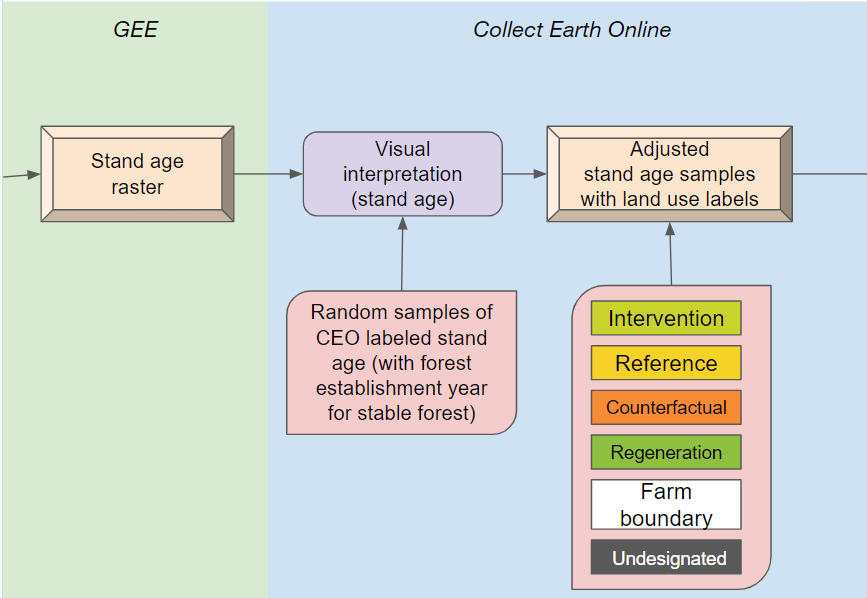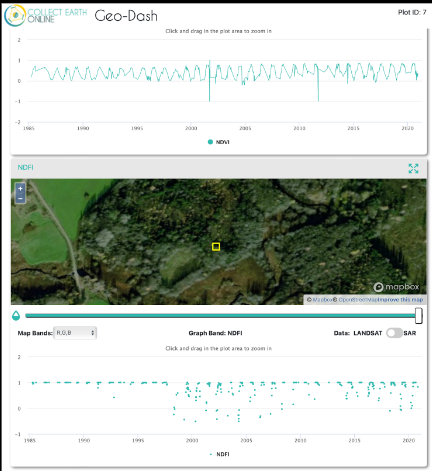2. Interpret stand age
All maps have systematic errors, and with pixel-counting alone we are likely either overestimating or underestimating stand age and the associated carbon removals. We apply a sample based approach on top of the map in order to characterize and correct for systematic map errors.
The next step of the carbon accounting process is to use a sample based approach to correct systematic bias in our stand age map and estimate uncertainty (Oloffson et al. (2014)).
We interpret the stand age of a series of samples. Plots are assessed in Collect Earth Online (CEO, Saah et al. 2019) using time series information and imagery. We apply the sample based approach because just counting pixels in a map doesn’t provide any estimates of uncertainty. All maps have errors, and with pixel-counting one cannot know whether stand age is overestimated or underestimated

2.1 Sample Design
We place a probabilistic sample of plots across the study site. Note, we do not exclude places that are mapped as non-tree cover, since these could be errors as well as lands mapped as having tree cover (with associated stand ages).
We will upload this probabilistic sample into a project in Collect Earth Online (CEO).
2.2. Image interpretation
Once the sample has been generated, we create a project in CEO to do image interpretation of the forest dynamics at each sample plot using time series information and imagery. The questions we answer in CEO include questions about forest loss/gain events (and year of the event) along with the land cover in the final year (e.g. 2021).
We answer a series of questions for each plot in Collect Earth Online (CEO). First we assess the available high resolution imagery and time series graphs of Landsat images. These are use to label forest dynamics at samples. The questions that are used for carbon accounting include ones about year of forest loss/gain events along with land cover in 2021. Note: Crystal/Andrea/Vanessa, we need to double check what questions are in the new vs. old CEO projects

2.3 Post-processing of sample answers
For young forests, where interpreters have indicated there were loss or regrowth activities, we need to convert the CEO questions into an establishment age. We use the following approach to determine the establishment age. After forest loss, if there was a subsequent indication of regrowth (or the interpreter indicated that the land cover in the final year was forest) we set the stand age at 0 when the loss event occured. Then we increase the stand age in annual increments. Since forest regrowth is only detectable after trees begin maturing, we cannot count the year of regrowth as stand age of 1 (it is likely older than 1 year). Therefore we begin aging the stand immediately after loss, starting at age 1. If the earliest recorded forest change event is gain (e.g. 1990), we assume it started growing four years earlier (in 1986) (e.g., we can see trees approximately 4 years old using image interpretation). If no land change event was detected, that sample is a stable forest or non-forest based on CEO answer for final year land cover (e.g. 2021). For stable forest samples, we set the stand age to be increasing from 37.5 years starting from 2017 if stand age in the initial years cannot be determined through previous logic.
How to assign stand ages based on CEO questions
- If no land change event was detected, assume stable land cover 1985-end
- Labeled stable forest or non-forest based on CEO answer for final year land cover
- Set stand age to 0 at the year of a forest loss
- After forest loss, if there was a subsequent indication of regrowth or the land cover in the final year was forest, we increased the stand age in annual increments. Since forest regrowth is only detectable after trees begin maturing, we cannot count the year of regrowth as stand age of 1 (it is likely older than 1 year). Therefore we begin aging the stand immediately after loss, starting at age 1.
- If earliest recorded forest change event is gain (e.g. 1990), we assume it started growing four years earlier (in 1986) (e.g., we can see trees approximately 4 years old using image interpretation)
- Assume stand age to be increasing from 37.5 years of age starting from 2017 if stand age in the initial years cannot be determined through previous logic